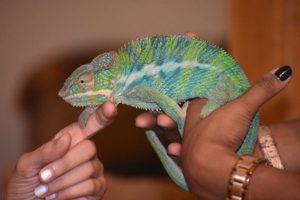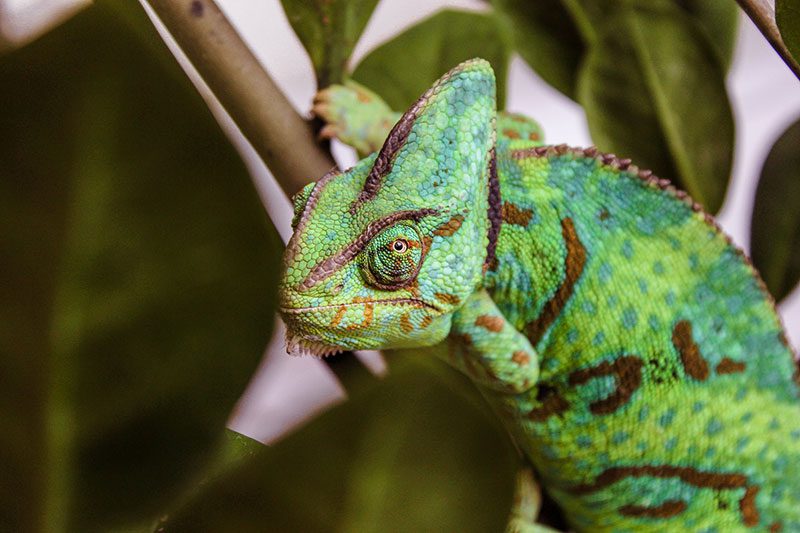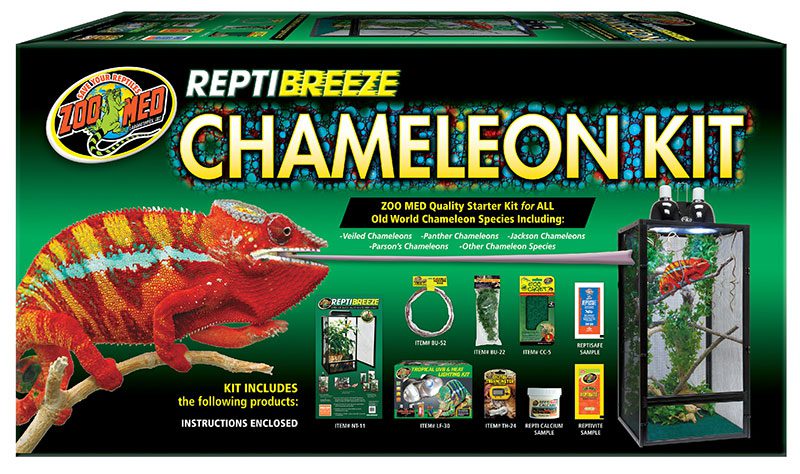Chameleon care is extremely delicate. As a result, they are not recommended for novice reptile owners. However, owning a chameleon can be very rewarding if you have some experience with reptiles, time to devote to it, and are up for the challenge. One very important point to keep in mind is that chameleons are extremely independent animals. For the most part, chameleons can get incredibly stressed out when their owners attempt to hold or pet them. They’re also very delicate and can get injured if handled the wrong way. It somewhat depends on the chameleon and the owner. It is also almost always recommended to keep chameleons alone in their space. Putting two together can cause territorial fights, sickness, and/or death.
So, if you’re wondering whether chameleons are good pets, it depends on whether the owner is okay having a pet that he or she will not be able to handle very much.
What’s the Best Enclosure for a Chameleon?
The natural chameleon habitat is almost exclusively trees. As a result, they need a lot of foliage, branches and climbing space. In addition, things like gravel, bark, moss and sand need to be avoided. They’re harmful to chameleons and they could accidentally eat some of it while catching their prey.
The recommended chameleon enclosure for the larger breeds is at least 3-by-3-by-4-foot tall. However, a larger chameleon enclosure is always better. It’s also best to coat the sides of the enclosure with vinyl wire or poly mesh to prevent toe and foot injuries.
Some chameleons thrive in hotter temperatures, others in cooler temperatures, depending on the specific breed. To provide adequate care, the chameleon enclosure should be adjusted accordingly.
In nature, chameleons get their water from leaf drops, which means that they typically won’t take water from a dish or any other enclosed container. Instead, to provide proper chameleon care, owners should either invest in an artificial drip system, place ice cubes on top of the enclosure or mist the enclosure at least twice daily.
Note that especially for breeds that do well in hotter temperatures, misting also helps to maintain humidity levels. With drip systems, excessive water can cause the humidity to get too high. As a result, any excess water should be carefully removed.
Chameleons need about 10 hours of exposure to both UVA and UVB rays. Natural sunlight through a window helps somewhat, but most types of glass filter out UV rays.
It is generally recommended to leave new chameleons alone for about the first three or four days after bringing them home. This is to see how well it acclimates to its new environment. A veterinarian should be contacted if any of the following occurs:
- Spends almost all of its time hiding
- Has loose stools for more than two days
- Swollen joints
- Discharge in the eyes, nose or mouth
- Discolored shedding
What Do Chameleons Eat?

Briesha Bell on Unsplash
The primary chameleon diet is insects. They’ll generally eat roaches, crickets, certain types of worms and moths. It is recommended to dust the insects with calcium twice a week. Some breeds also require foliage, such as mustard greens, in their diet. Small pieces of fruit, such as mangoes or blueberries, also can be included.
It is important to always select food rich in calcium and other multivitamins. But never select anything that’s phosphorus or contains Vitamin A or D3. Chameleons easily overdose on these and it can eventually become fatal.
Generally, it’s recommended to give chameleons about four hours to eat from the time of feeding, then remove any leftovers afterwards.
How Big Do Chameleons Get?
Chameleons generally grow up to about 27 inches long and males are usually larger than females. Females grow to about 14 inches long. They’re generally only about four inches when they first hatch. Size varies depending on the breed.
How Long Do Chameleons Live?
Lifespan depends on the breed. However, the average chameleon lifespan is between three and 10 years in captivity.
Chameleons are generally not considered to be the best pets. This is mainly because they don’t like to be held or petted; they’re very solitary and delicate. Also, some of their needs vary according to their specific breeds. Chameleons are generally not recommended for beginners or first-time reptile keepers.



